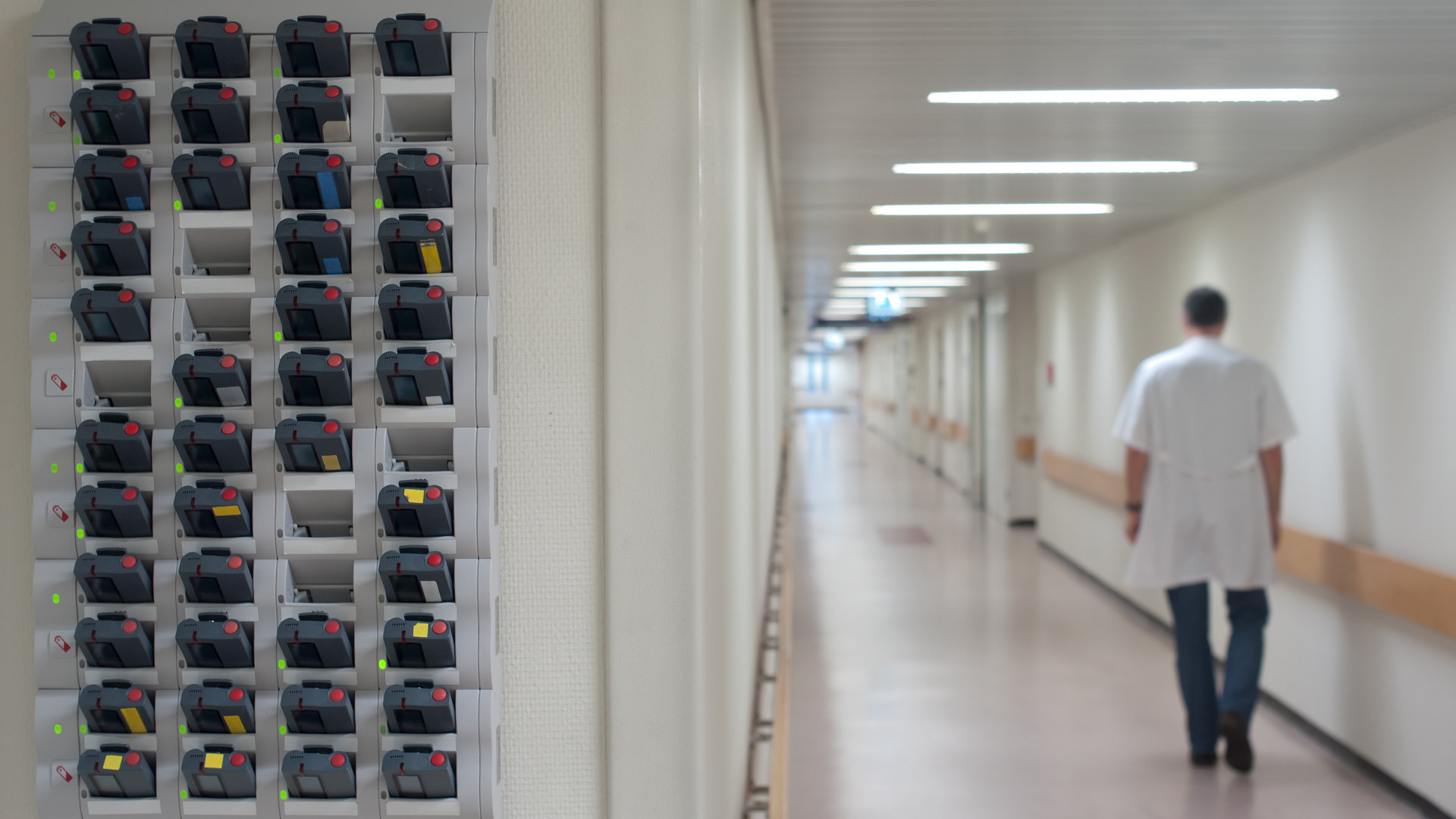For many years, the pager was an iconic symbol in hospitals, instantly recognizable as the tool that kept doctors connected and responsive. However, with the relentless march of technology, particularly the advent of smartphones and sophisticated communication platforms, the role of pagers in modern healthcare has been increasingly questioned. Are pagers still a common sight in hospitals in 2023, or are they becoming relics of a bygone era?
 A doctor holding a pager, illustrating the traditional communication method in hospitals.
A doctor holding a pager, illustrating the traditional communication method in hospitals.
While it might be surprising to some, the answer isn’t a definitive “no” just yet. Pagers, often referred to as beepers, haven’t completely vanished from the healthcare landscape. However, it’s more accurate to say that their presence is significantly diminished, and they are steadily being replaced by more advanced and versatile communication technologies. The era of the pager as the primary communication tool for doctors is undoubtedly drawing to a close.
One of the key drivers behind this shift is the inherent limitations of pagers in today’s fast-paced and technologically rich healthcare environment. Traditional pagers are fundamentally one-way devices. They excel at delivering a simple numeric or alphanumeric message, alerting the recipient to call back, but that’s where their functionality ends. In a world demanding instant, interactive communication, this one-way nature is a significant drawback.
Consider the complexities of modern patient care. Doctors often need to exchange detailed information quickly, collaborate with multiple colleagues simultaneously, and receive immediate updates on patient status. Pagers fall short in several crucial areas:
- Limited Communication: Pagers cannot receive replies or provide context beyond a brief message. This necessitates a separate phone call for every page, adding extra steps and potentially delaying critical information exchange.
- Lack of Multimedia Support: Modern healthcare often relies on visual information – images, videos, and graphs. Pagers are incapable of transmitting any form of multimedia, hindering efficient communication in situations where visual data is essential for diagnosis or treatment planning.
- Inefficient for Complex Scenarios: Coordinating complex procedures, managing emergencies, or disseminating updated protocols across teams becomes cumbersome and slow when relying solely on pagers.
Furthermore, the infrastructure required to operate pagers presents its own set of challenges. Hospitals need to maintain separate pager networks, which incur costs for setup, maintenance, and upkeep. In contrast, the widespread availability of reliable wireless networks means that modern communication tools like smartphones can leverage existing infrastructure, often proving more cost-effective in the long run.
The 21st century has ushered in a new era of healthcare communication, characterized by sophisticated tools designed to enhance efficiency, improve patient safety, and streamline workflows. Smartphones, equipped with secure messaging applications and integrated with hospital communication systems, have emerged as powerful alternatives to pagers. These devices offer:
- Two-Way Communication: Enabling real-time conversations, instant clarification, and faster decision-making.
- Multimedia Capabilities: Facilitating the sharing of images, videos, and other essential visual information directly and securely.
- Integration with Hospital Systems: Connecting with electronic health records (EHRs), on-call scheduling systems, and other platforms to create a unified communication ecosystem.
- Enhanced Documentation: Providing a comprehensive record of communications for audit trails, compliance, and improved care coordination.
Virtual pager systems, such as Hypercare, represent an intelligent evolution of the traditional pager concept. These systems leverage the ubiquity of smartphones and the power of software to deliver the core functionality of pagers while overcoming their limitations. Instead of carrying a separate pager device, doctors can utilize an application on their smartphone that acts as a virtual pager, offering a host of advanced features:
- Enhanced Reliability: Virtual pager systems often utilize multiple networks and sophisticated delivery mechanisms to ensure messages are reliably sent and received, often exceeding the dependability of traditional pager networks.
- Improved Escalation Protocols: Critical messages are less likely to be missed. If a message isn’t acknowledged within a set timeframe, the system can automatically escalate it to another team member, ensuring timely responses to urgent situations.
- Smarter Alert Management: Modern systems can differentiate between routine notifications and high-priority alerts, reducing alert fatigue by ensuring clinicians are only assertively notified for truly critical matters. This is a significant improvement over pagers, which treat all messages with the same level of urgency.
- Seamless Integrations: Virtual pager systems can integrate with other hospital systems, streamlining communication and workflow. For example, alerts can be triggered directly from EHR systems or lab results platforms.
- Flexibility and Context: Unlike the character limits of pagers, virtual systems allow for richer messages with more context, reducing the need for follow-up calls and enabling faster understanding of the situation. Furthermore, features like “do-not-disturb” exceptions ensure urgent messages are still received even when a doctor is in focused work mode.
Addressing alert fatigue is a crucial aspect of modern healthcare communication. Traditional pagers, by their nature, contribute to this problem by delivering every notification with the same insistent beep, regardless of urgency. Virtual pager systems like Hypercare are designed to mitigate alert fatigue by intelligently prioritizing notifications. The application can distinguish between routine messages and critical alerts, ensuring that doctors are promptly and assertively notified only when immediate attention is required for acute patient care. This nuanced approach helps to reduce the constant barrage of alerts, allowing clinicians to focus effectively and respond decisively when truly needed.
In conclusion, while pagers may still be found in some corners of healthcare facilities, their use is undeniably diminishing. The limitations of pagers in the face of increasingly sophisticated communication needs, coupled with the rise of powerful and versatile alternatives like smartphones and virtual pager systems, are driving a clear shift. The answer to “Do Doctors Still Use Pagers?” in 2023 is becoming less and less affirmative. The future of hospital communication is undoubtedly digital, integrated, and designed to empower healthcare professionals with the tools they need to provide the best possible patient care.
